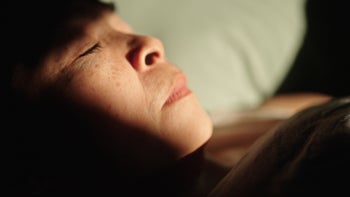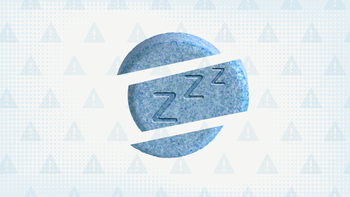
7 Items That Help Me Deal With Insomnia — My Medicine Cabinet
Key takeaways:
During the pandemic, Méline Nadeau thought a lot about the things keeping her up at night.
Her insomnia left her sleepless for days.
She started researching ways to cope with her sleep issues. This is what works for her.

Our Medicine Cabinet series explores what real people keep on hand and consider essential for their particular needs — even if a doctor didn’t prescribe it.
Méline Nadeau has had sleep issues since childhood.
Her sleepless nights are usually fueled by what she calls “monkey brain,” or constant disruptive chatter in the mind. Méline’s insomnia was anxiety-triggered, and it only worsened when the pandemic began.
“I was sleepless for days,” says Méline, a sleep coach and clinical psychology student. “It’s not just me. Two years of stress, anxiety, and grief means there are a lot of very tired, messed-up people out there. The whole world has changed, and it’s had a major ripple effect on our mental health.”
The CDC says about 70 million Americans have chronic sleep problems. A lack of sleep can lead to greater injuries, illness, and poor quality of life and well-being.
Tips for getting some rest
Méline’s medicine cabinet includes items that she says “take care of all the senses” to get ready for a sound night’s rest. Her go-to items include:
1. Sleep spray
Sleep sprays, usually a mix of an essential oil and an unscented base like distilled water, are often part of Méline’s evening ritual. She says fragrances can be sensory cues for meaningful memories and tell your body it’s time to rest.
Popular scents include lavender and chamomile, both of which have calming properties. Méline likes a touch of lavender with hints of patchouli and sandalwood because it reminds her of her grandmother’s house. Sleep sprays are available in stores or made at home. Méline has written about how she makes them herself. She says they’re especially good for people who travel often.
2. Ear plugs or sleep headphones
Some people prefer ear plugs that block almost all unwanted sounds. Méline prefers sleep headphones, which resemble a headband and have a Bluetooth streaming option.
“You know the saying, ‘4AM knows all my secrets?’ That was me,” she says. “I’d wake up in the middle of the night, and my mind would start churning — going from to-do lists to ‘I wish I hadn’t said this or that,’ or rehashing the past or having arguments in my head. I had to give my mind something to focus on, whether it was a 5-minute meditation or a podcast. Or if you want to fall asleep to a famous actor’s voice, you can do that.”
3. A sleeping mask
Méline recommends soft sleeping masks that aren’t too tight. Some are made of cooling fabrics, like silk. Others are weighted and work well for people who sleep on their backs. It’s just another way to block out light and tell your brain it’s time to rest, she says.
Search and compare options
4. Comfortable sleeping clothes and sheets
Méline says silk pillowcases are a game-changer. For clothing, she prefers soft and comfortable fabric. For children who have difficulty falling asleep, she suggests tucking them in with something that’s been worn by someone who comforts them or giving them a weighted plushie to sleep with.
5. A before-bed drink
Consider having a warm drink like chamomile tea before you get into bed, Méline suggests. Or keep water on your nightstand in case you wake up in the night. Although, that suggestion may not work for everyone, since some people have sleep disruption because they need to make many trips to the bathroom. Still, Méline says, there’s no need to buy expensive products that promise to help you fall asleep. Those products may work for a few days, but you’ll get accustomed to them quickly and they’ll stop being effective, Méline says. She works on her sleep hygiene instead.
6. Keep a journal at the ready
It doesn’t have to be anything fancy — a regular notebook will do — but Méline says having paper and pen nearby is a good idea. Awakened by a bad dream? Describe it in your bedside journal as a way of putting it behind you. Have a to-do list churning through your brain? Write it down.
“Jot notes, set reminders, anything that will allow you to quiet your mind,” she says.
7. When traveling, bring a night light
Méline finds that sometimes, hotel blackout curtains work too well. A nightlight can ease anxiety when you wake in the middle of the night and are confused by your surroundings, she says.
A couple more recommendations for better sleep
In addition to items she has on hand to deal with insomnia, Méline has a couple more words of advice:
Avoid blue light at night. Screen time before bed can stimulate your brain and make it harder to fall asleep. “Scrolling through your phone is the absolute worst thing you can do,” she says.
Try performative meditation. That’s a combination of meditation and art. It can include “zentangles,” doodles that begin with a simple shape and then call for added circles and lines as the act of repetition builds focus. “You don’t have to be an artist to do it,” Mélina says. “Just channel your inner child.” Or try journaling, Méline suggests. “Some people say they don’t know what to write, but there are sleep journals with prompts. So all you have to do is fill in the blanks.”
Méline’s experimentation with coping techniques have helped her get deep, restful sleep. Her pandemic experiences with sleeplessness prompted her to launch cantsleepatnite.com, where she offers wellness tips and other sleep-related advice.
“Sleep has a huge impact on your physical and mental well-being,” she says. “It can help you reframe things in a more positive light and move on. You look good and you feel good, so you smile at me, and I smile at you.”

Want to tell your patient story? Email us at patientstories@goodrx.com.
Why trust our experts?






























